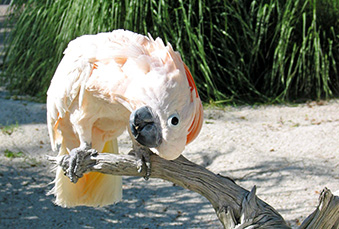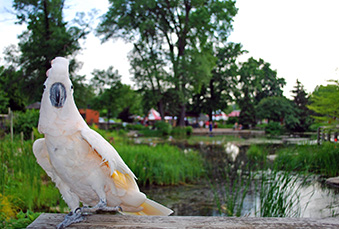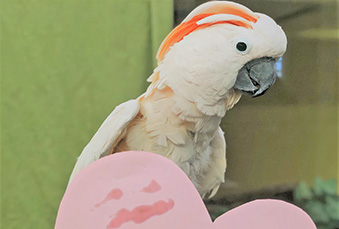Cacatua moluccensis | Moluccan Cockatoo
Name: Wedgie (Female)



Meet Wedgie
Say hello to Wedgie, our stunning and incredibly intelligent Moluccan Cockatoo! With her soft, light pink feathers and striking salmon-pink crest, Wedgie certainly knows how to turn heads—and steal hearts. Native to the Moluccan Islands of Indonesia, Moluccan cockatoos are one of the largest and loudest species of cockatoos in the world. Their vocalizations can reach over 130 decibels—about as loud as a jet engine! But behind their volume is a brilliant mind and a personality, making them favorites among bird lovers.
Communication: Loud, Clever, and Expressive
Wedgie is loud—very loud. But there's a reason for that: Moluccan cockatoos use their powerful calls to communicate over long distances in the dense rainforests where they live. Though their vocalizations may seem jarring to us, they are essential for survival in their natural habitat. In addition to their impressive vocal range, Moluccan cockatoos can mimic human speech, and Wedgie enjoys saying her name and calling herself a “pretty girl” on her talkative days.
These birds don’t just rely on sound; they also use their feathers to communicate. Their crest and the feathers around their beak puff up to express emotions, much like a human’s facial expressions.
Amazing Adaptations for Survival
Moluccan cockatoos have several unique traits that help them thrive in the wild:
- Powerful Beak: Their beak has a bite force of about 350 psi—equivalent to a Husky dog’s bite strength. This helps them crack open hard nuts and seeds.
- Zygodactyl Feet: With two toes pointing forward and two pointing backward, they have excellent dexterity, allowing them to hold food and navigate through trees with ease. They even use their beak as a third foot while moving through the forest.
- Powder Down Feathers: To keep clean and dry, these birds have special feathers called powder down. As the tips of these feathers disintegrate, they release keratin—a substance also found in human hair and nails—that helps waterproof their feathers.
Fact Sheet
Taxonomy
Genus: Cacatua | Species: moluccensis |
Kingdom: Animalia | Phylum: Chordata | Class: Aves | Order: Psittaciformes | Family: Cacatuidae |
Favorite Enrichment Type
BIG Colorful bird toys!
Life Span
- In the Wild: 30+ years
- In Human Care: 65 to 70+ years
Diet
- In the Wild: Seeds, nuts, fruits, berries, insects, and larvae
- At the Zoo: Fresh produce and corn
Geographic Range
Maluku islands (Moluccas) of Indonesia.
Habitat
Lowland rainforests, mangrove forests, and coastal forests.
Status: Endangered
Breeding & Conservation
Moluccan cockatoos are monogamous, meaning they form lifelong bonds with their mates. During breeding season, both males and females share the responsibility of incubating their eggs. While Wedgie may be having a great time shaking things up at the zoo, her wild counterparts face significant threats. Deforestation, capture for the illegal pet trade, and habitat fragmentation are all contributing to their endangered status. As a result, Moluccan cockatoos are classified as Endangered. Conservation efforts focus on protecting their natural habitats, preventing poaching, and raising awareness about their plight.
Why Wedgie Isn't a Pet (And Shouldn't Be)
While it’s easy to fall in love with birds like Wedgie, they require specialized care that makes them unsuitable as pets for most people. Here’s why:
- Longevity: Moluccan cockatoos can live for over 70 years—longer than many people are prepared to care for them.
- Attention and Stimulation: These intelligent birds need constant mental stimulation to avoid stress and destructive behaviors. Without enough interaction, they can develop self-destructive habits like feather plucking.
- Noise Level: Moluccan cockatoos are incredibly loud, with calls that can rival the sound of construction equipment.
Unfortunately, many cockatoos end up surrendered to rescues or live in poor conditions when their care becomes overwhelming. If you would like to learn more about why domestic animals are the best pets for most people, check out the Not-a-Pet campaign!
Support Conservation and Responsible Bird Care
Wedgie serves as a reminder that while these birds are beautiful and intelligent, they’re not suited for life as pets. Instead, we encourage supporting conservation efforts and responsible bird care through:
- Visiting AZA-accredited zoos that provide expert care.
- Donating to bird rescues and sanctuaries.
- Saying NO to the illegal wildlife trade.
If you’re considering a feathered companion, remember to adopt—not shop—and always prioritize the well-being of the bird. There are many cockatoos in rescues waiting for the right person to care for them.
The Importance of Conservation
Moluccan cockatoos play an essential role in their ecosystems as seed dispersers, helping maintain the health of the forests they inhabit. At the zoo, Wedgie helps raise awareness about the challenges facing her species. Her story is one of beauty, intelligence, and the urgent need for conservation action.
So, next time you’re near the Wobbly Bridge, be sure to stop by and say hello to Wedgie. Her vibrant personality and the important message she shares will leave a lasting impression. Just remember—while we can love birds like Wedgie with our hearts, they are best appreciated in their natural habitat, not as pets.
How to Find Me
Looking to meet Wedgie? Head on over to our Aviary, nestled between our Outback viewing deck and the white-throated capuchin habitat. You can find her in one of the side habitats, viewable from the outback viewing deck! If in a talkative mood, you will be able to hear her throughout the zoo!
